The eagerly awaited 4-engine bombers B-17 and Avro Lancaster are now hitting the stores in four WW2 Wings of Glory Special Packs. So, let’s learn more about these aircraft and the versions featured in the game, starting with the B-17 Flying Fortress, designed by Boeing to address the United States Army Air Corps (USAAC) 1930s request for a large, multi-engine bomber.
The B-17 prototype design started in June, 1934, and only one year later (July 1935) it was ready for its first flight. Called Model 299, the prototype was a low-wing monoplane combining the aerodynamic features of the XB-15 giant bomber (which was still in the design stage) and the Model 247 transport. It was the first Boeing military aircraft with a flight deck, instead of an open cockpit. It was armed with bombs and five .30-caliber machine guns mounted in clear "blisters." The heavy defensive armament resulted in the bomber being called the "Flying Fortress" by the members of the press in attendance.
Despite the prototype's crash in October, the US Army Air Corps (USAAC) decided to continue testing anyway due to its impressive speed and handling, and 13 YB-17s were ordered. The YB-17 incorporated a number of significant changes from the Model 299, including more powerful Wright R-1820-39 Cyclone engines replacing the original Pratt & Whitneys. It had five machine guns, room for 4,800 pounds of bombs, and a crew of nine.
After testing, an improved prototype, the Y1B-17, was built with Wright Cyclone radial engines. Twelve were delivered to the USAAC's 2nd Bombardment Group for trials. One of these was soon equipped with new Moss/General Electric turbochargers, which became standard on all future Flying Fortresses.
The first B-17s saw combat in 1941, when the British Royal Air Force (RAF) received their first B-17Cs and used them in daylight raids over Germany. The defensive armament soon proved inadequate, however, and the B-17's altitude capability was little defense against the German fighters. Orders for a new model (the B-17D) based on lessons learned in bombing missions over Europe were soon placed, which included self-sealing fuel tanks and more armor.
The B-17E, the first mass-production model Flying Fortress, carried nine machine guns and a 4,000-pound bomb load. It was several tons heavier than the prototypes and bristled with armament. It was the first Boeing airplane with the distinctive - and enormous - tail for improved control and stability during high-altitude bombing. Other versions followed, with B-17F the first to serve with the USAAF 8th Air Force. The final major version, the B-17G, added a chin turret with dual machineguns, which gave a defensive armament of 13 guns to the aircraft.
The B-17 was primarily employed by the USAAF in the daylight, precision strategic bombing campaign against German industrial and military targets. The US 8th Air Force, based in southern England, and the 15th Air Force, based in Italy, complemented the RAF Bomber Command's nighttime bombing in the Combined Bomber Offensive, which helped secure air superiority over the cities, factories, and battlefields of Western Europe in preparation for the 1944 invasion of France.
The B-17 also participated to a lesser extent in the early War in the Pacific, where it conducted raids against Japanese shipping and airfields. There, the B-17s earned a deadly reputation with the Japanese, who dubbed them "four-engine fighters." Their ability to stay in the air after taking brutal poundings were legendary.
The B-17s is often regarded as the more important heavy bomber for Allies in WW2, with 290,000 sorties and over 640,000 tons of bombs dropped. A total of 6,981 B-17s were built in Boeing plants, and another 5,745 were produced under a nationwide collaborative effort by Douglas and Lockheed (Vega). After the war, several dozen B-17s lived on as fire-bombers and aerial surveyors until the last one was retired in the 1970s. A few B-17s have been restored, and today 13 currently fly – 11 in the United States, one in the UK, and another in France.
B-17 in Wings of Glory
The two B-17s featured in the WW2 Wings of Glory Special Packs are the B-17F “Memphis Belle” and the B-17G “A Bit-o’Lace.”
The B-17F “Memphis Belle” (serial number 41-24485, nicknamed in honor of the pilot's wartime sweetheart) became the most famous Flying Fortress, because it was the first heavy bomber in WW2 to complete 25 combat missions over Europe without any loss to its crew (flying from November 7, 1942 to May 17, 1943). At the time, 80% of the bombers were shot down during the first three months of America's combat flights over Europe, so command generals set 25 missions as an incentive for air crews to go home.
The Memphis Belle participated in some of the most risky raids of the war, when the Luftwaffe still had a commanding fighter superiority and the defenses of the Nazi regime were strong. It was bullet-ridden, flak-battered, and on five separate occasions had one of her engines shot out.
During its 25 missions, it flew 148 hours, 50 minutes, and covered more than 20,000 combat miles. Its gunners were credited with destroying eight enemy fighters, with five others probably shot down, at least a dozen more damaged, and more than 60 tons of bombs dropped over France, Germany, and Belgium. Her targets included supply depots, railway yards, aircraft plants, and an assortment of military bases. Its 25th and last mission was a bombing raid against Lorient, a German submarine base.
The 26th mission was to return to the States during the summer of 1943 on a public relations tour to thank the American public for supporting the war effort. After that, the Belle flew stateside in the training command. The Memphis Belle inspired the making of two movies: a 1944 documentary film, “Memphis Belle: A Story of a Flying Fortress,” and a 1990 Hollywood feature film, “Memphis Belle.” The aircraft is currently undergoing extensive restoration at the National Museum of the United States Air Force.
The B-17G “A Bit o’Lace” flew 83 missions with the 447th Bomb Group. It crossed to England on 18h June 1944, shortly after D-Day, and began combat flights on July 6th. Its first target was in the Pas de Calais region of France. It was the first of many lead roles. It took the lead at least 20 times, including the August 18th sortie with the 4th 'A' combat wing to St Dizier airfield. The aircraft was also taken by the group commander, Col. Wrigglesworth, to attack Brest harbor installations on September 5th.
From mid October, "A Bit o' Lace" settled into regular missions and was assigned to a number of pilots. Lt Warren Bates' crew performed 15 combat missions in the plane. Tom Mustaleski took it to Kiel on 4th April, suffering serious flak damage in the tail, but he managed to bring the ship home. In 83 total missions, not a single one was aborted due to mechanical failure - a remarkable achievement for its ground crew.
The plane was named by Milt Caniff, after a request by Lt. John Bauman seeking permission to use his popular comic strip personality "Miss Lace." Caniff sent a sketch entitled "A Bit o' Lace" and Nick Fingelly used his skill to apply it to the nose of the airplane. After the war, the B-17G “A Bit o’Lace” ended up in Kingman, Arizona, where it was scrapped.
Information sources: Boeing, Warbird Alley, Ace Pilots, Military Factory, Memphis Belle.com, HystoryNet.com, USAAF Nose Art Research Project, Wikipedia.

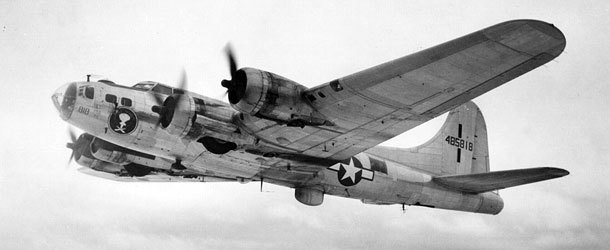
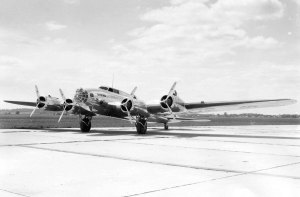
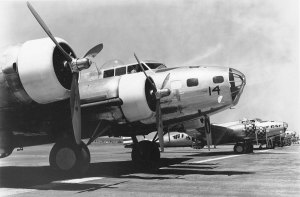
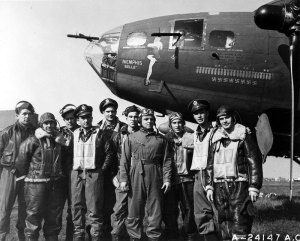
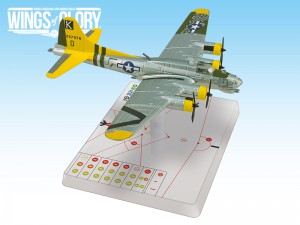








Follow Us on